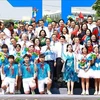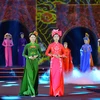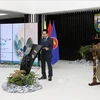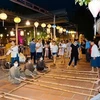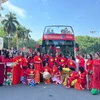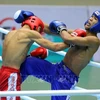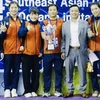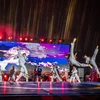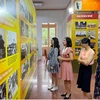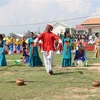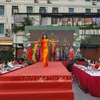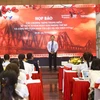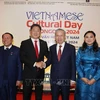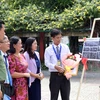 “Mung lua moi” (the new rice celebration) of the Ba Na ethnic people in the Central Highlands province of Gia Lai’s KBang district was restored during the “Great National Unity – Vietnam’s Cultural Heritage” week, held at the Vietnam National Village for Ethnic Culture and Tourism in Son Tay town on the outskirts of Hanoi from November 16 to 23. The celebration aims to preserve and uphold the traditional cultural value of Vietnamese ethnic communities and enhance the great national unity bloc, while promoting the Vietnam National Village for Ethnic Culture and Tourism as an attractive tourist destination among visitors from both home and abroad. (Photo:VietnamPlus)
“Mung lua moi” (the new rice celebration) of the Ba Na ethnic people in the Central Highlands province of Gia Lai’s KBang district was restored during the “Great National Unity – Vietnam’s Cultural Heritage” week, held at the Vietnam National Village for Ethnic Culture and Tourism in Son Tay town on the outskirts of Hanoi from November 16 to 23. The celebration aims to preserve and uphold the traditional cultural value of Vietnamese ethnic communities and enhance the great national unity bloc, while promoting the Vietnam National Village for Ethnic Culture and Tourism as an attractive tourist destination among visitors from both home and abroad. (Photo:VietnamPlus)  Xoang dance at the new rice celebration. Xoang dance has been an inseparable part of Central Highlands culture. During important festivals, ethnics in the Central Highlands play gongs and perform Xoang dancing. Xoang is a traditional community dance performed by ethic groups who live in the Central Highlands, particularly the Ba Na. To beat drums and gongs, people form a circle and move anticlockwise slowly and rhythmically. Men and women take small steps and sway their body and arms slowly. They dance in the front yard of the communal house, around a tall bamboo pole called Neu tree, which is believed to ward off evil spirits. The Xoang dance describes a person’s lifespan. Movements imitate daily activities such as catching an animal, lighting a fire, cutting trees, and sowing seeds, and expressing emotions like love, compassion, and hate. (Photo: VietnamPlus)
Xoang dance at the new rice celebration. Xoang dance has been an inseparable part of Central Highlands culture. During important festivals, ethnics in the Central Highlands play gongs and perform Xoang dancing. Xoang is a traditional community dance performed by ethic groups who live in the Central Highlands, particularly the Ba Na. To beat drums and gongs, people form a circle and move anticlockwise slowly and rhythmically. Men and women take small steps and sway their body and arms slowly. They dance in the front yard of the communal house, around a tall bamboo pole called Neu tree, which is believed to ward off evil spirits. The Xoang dance describes a person’s lifespan. Movements imitate daily activities such as catching an animal, lighting a fire, cutting trees, and sowing seeds, and expressing emotions like love, compassion, and hate. (Photo: VietnamPlus)  The spring or new rice festival is held by Ba Na, together with E De, Gia Rai, Xo Dang and M’Nong ethnic groups in the Central Highlands after harvest time to welcome a new year. Dedicated to the god of rice, the festival is held in early lunar new year to wish for favourable weather for crops. It also seeks support from gods for good health and prosperity for all villagers. Ritual offerings include newly harvested fragrant rice, ruou can (rice wine drunk from a jar through stalks), a cockerel, a hog and meat of wild animals. During the festival, a rite dedicated to the god of water is conducted to ask for clean water, implying good health for villagers. On festive days, villagers drink ruou can and dance to the sounds of gongs. (Photo: VietnamPlus)
The spring or new rice festival is held by Ba Na, together with E De, Gia Rai, Xo Dang and M’Nong ethnic groups in the Central Highlands after harvest time to welcome a new year. Dedicated to the god of rice, the festival is held in early lunar new year to wish for favourable weather for crops. It also seeks support from gods for good health and prosperity for all villagers. Ritual offerings include newly harvested fragrant rice, ruou can (rice wine drunk from a jar through stalks), a cockerel, a hog and meat of wild animals. During the festival, a rite dedicated to the god of water is conducted to ask for clean water, implying good health for villagers. On festive days, villagers drink ruou can and dance to the sounds of gongs. (Photo: VietnamPlus)  A Ngui, staff of Kbang district’s culture, sport and information centre, said the new rice festival always takes place in November and December when rice fields turn yellow. The village patriarch chooses a specific date for the new rice celebration, then informs all villagers. During the festival, villagers pay tribute to their gods, called yang, particularly Yang Sri (Rice God) for ensuring good weather for bumper crops. Billed as the largest festival of the Ba Na ethnic minority group in the Central Highlands, the festival includes two parts: the ritual to thank gods and pray for good fortune in the new year, and the festive activity with jubilant dances and songs to celebrate good crops. (Photo: VietnamPlus)
A Ngui, staff of Kbang district’s culture, sport and information centre, said the new rice festival always takes place in November and December when rice fields turn yellow. The village patriarch chooses a specific date for the new rice celebration, then informs all villagers. During the festival, villagers pay tribute to their gods, called yang, particularly Yang Sri (Rice God) for ensuring good weather for bumper crops. Billed as the largest festival of the Ba Na ethnic minority group in the Central Highlands, the festival includes two parts: the ritual to thank gods and pray for good fortune in the new year, and the festive activity with jubilant dances and songs to celebrate good crops. (Photo: VietnamPlus)  A Ngui was the script writer and director of the “mung lua moi” celebration, which reflects the Ba Na ethnic minority group’s primitive beliefs and fertility belief. They believe in Yang Nui (God of Mountain) and Yang Song (God of River), as well as fairy tales that explain natural phenomena around them. Each family needs to prepare one chicken, an alcohol jaw, and young rice. The Ba Na ethnics can celebrate the festival within their family, or gather at a large space to celebrate the event with the whole village. Preparation for the festival is assigned by the village patriarch, with middle-aged men making offerings to the god, and women preparing mortar and pestle, pot and rice to pound rice to make “com” (young rice). (Photo: VietnamPlus)
A Ngui was the script writer and director of the “mung lua moi” celebration, which reflects the Ba Na ethnic minority group’s primitive beliefs and fertility belief. They believe in Yang Nui (God of Mountain) and Yang Song (God of River), as well as fairy tales that explain natural phenomena around them. Each family needs to prepare one chicken, an alcohol jaw, and young rice. The Ba Na ethnics can celebrate the festival within their family, or gather at a large space to celebrate the event with the whole village. Preparation for the festival is assigned by the village patriarch, with middle-aged men making offerings to the god, and women preparing mortar and pestle, pot and rice to pound rice to make “com” (young rice). (Photo: VietnamPlus)  Ba Na men cut the neck of chickens to put blood on bamboo card, which will be taken to the forest later to raise up the spirit of Yang Sri (God of Rice). When everything is ready, the village patriarch starts the worship ritual by saying “Yang Sri, Yang Mountain Cho Lay, Yang River Ba! As our village is celebrating the first new rice festival, please come here, join us, and support us with bountiful harvest and good health for the next year”. Following a howl, Ba Na men beat the drums and gongs, and begin xoang dancing before coming to each family to congratulate them on the occasion of the new rice festival. (Photo: VietnamPlus)
Ba Na men cut the neck of chickens to put blood on bamboo card, which will be taken to the forest later to raise up the spirit of Yang Sri (God of Rice). When everything is ready, the village patriarch starts the worship ritual by saying “Yang Sri, Yang Mountain Cho Lay, Yang River Ba! As our village is celebrating the first new rice festival, please come here, join us, and support us with bountiful harvest and good health for the next year”. Following a howl, Ba Na men beat the drums and gongs, and begin xoang dancing before coming to each family to congratulate them on the occasion of the new rice festival. (Photo: VietnamPlus)  The Ba Na ethnics believe in Yang Nui (God of Mountain) and Yang Song (God of River), as well as fairy tales that explain natural phenomena around them. Each family needs to prepare one chicken, an alcohol jaw, and young rice. The Ba Na ethnics can celebrate the festival within their family, or gather at a large space to celebrate the event with the whole village. Preparation for the festival is assigned by the village patriarch, with middle-aged men making offerings to the gods, and women preparing mortar and pestle, pot and rice to pound rice to make “com” (young rice). During the festival, a rite dedicated to the god of water is conducted to ask for clean water, implying good health for villagers. (Photo: VietnamPlus)
The Ba Na ethnics believe in Yang Nui (God of Mountain) and Yang Song (God of River), as well as fairy tales that explain natural phenomena around them. Each family needs to prepare one chicken, an alcohol jaw, and young rice. The Ba Na ethnics can celebrate the festival within their family, or gather at a large space to celebrate the event with the whole village. Preparation for the festival is assigned by the village patriarch, with middle-aged men making offerings to the gods, and women preparing mortar and pestle, pot and rice to pound rice to make “com” (young rice). During the festival, a rite dedicated to the god of water is conducted to ask for clean water, implying good health for villagers. (Photo: VietnamPlus)  Along with new rice festival, thanksgiving is an important ceremony of the Ba Na ethnics. It is usually held during the lull after the new rice harvest. When children get married and move into their own houses, they will invite their families to a thanksgiving ceremony. Depending on their wealth, the children will prepare such offerings as a buffalo, a pig, or some chickens and a jar of wine. The thanksgiving ceremony is held for the families of both the husband and the wife to show equality in the family relationship. The ceremony lasts two days and involves both close family members and remote relatives. The ceremony has adopted some new features such as young people singing during the party, but it continues to be a vital tradition in the spiritual life of the Ba Na. (Photo: VietnamPlus)
Along with new rice festival, thanksgiving is an important ceremony of the Ba Na ethnics. It is usually held during the lull after the new rice harvest. When children get married and move into their own houses, they will invite their families to a thanksgiving ceremony. Depending on their wealth, the children will prepare such offerings as a buffalo, a pig, or some chickens and a jar of wine. The thanksgiving ceremony is held for the families of both the husband and the wife to show equality in the family relationship. The ceremony lasts two days and involves both close family members and remote relatives. The ceremony has adopted some new features such as young people singing during the party, but it continues to be a vital tradition in the spiritual life of the Ba Na. (Photo: VietnamPlus)  The Xoang dancers follow the beat of a Cho gut drum, which also leads the gong team. To the beat of drums and gongs, people form a circle and move anticlockwise slowly and rhythmically. Men and women take small steps and sway their body and arms slowly. They dance in the front yard of the communal house, around a tall bamboo pole called Neu tree, which is believed to ward off evil spirits. The Xoang dance describes a person’s lifespan. Movements imitate daily activities such as catching an animal, lighting a fire, cutting trees, and sowing seeds, and expressing emotions like love, compassion, and hate. (Photo: VietnamPlus)
The Xoang dancers follow the beat of a Cho gut drum, which also leads the gong team. To the beat of drums and gongs, people form a circle and move anticlockwise slowly and rhythmically. Men and women take small steps and sway their body and arms slowly. They dance in the front yard of the communal house, around a tall bamboo pole called Neu tree, which is believed to ward off evil spirits. The Xoang dance describes a person’s lifespan. Movements imitate daily activities such as catching an animal, lighting a fire, cutting trees, and sowing seeds, and expressing emotions like love, compassion, and hate. (Photo: VietnamPlus)  T’rung is one of the popular musical instruments closely associated with the spiritual life of the Ba Na ethnics as well as Giarai, Ede and other ethnic minority groups in the Central Highlands of Vietnam. It is made of short bamboo tubes differing in size, with a notch at one end and a beveled edge at the other. The long big tubes give off low-pitched tones while the short small ones produce high-pitched tones. The tubes are arranged lengthwise horizontally and attached together by two strings. T'rung is often played after back-breaking farm work and during evening get-togethers in the communal house around a bonfire with young boys and girls singing and dancing merrily. The sounds of the gong and T'rung also mingle together at wedding parties and village festivals. (Photo: VietnamPlus)
T’rung is one of the popular musical instruments closely associated with the spiritual life of the Ba Na ethnics as well as Giarai, Ede and other ethnic minority groups in the Central Highlands of Vietnam. It is made of short bamboo tubes differing in size, with a notch at one end and a beveled edge at the other. The long big tubes give off low-pitched tones while the short small ones produce high-pitched tones. The tubes are arranged lengthwise horizontally and attached together by two strings. T'rung is often played after back-breaking farm work and during evening get-togethers in the communal house around a bonfire with young boys and girls singing and dancing merrily. The sounds of the gong and T'rung also mingle together at wedding parties and village festivals. (Photo: VietnamPlus)  Another kind of T’rung instrument. As time goes by, T’rung instrument has been greatly improved. More tubes have been added, and as many as 48 tubes are arranged in three arrays capable of performing intricate piece of modern music while preserving the traditional sound scale. Some players have invented a stick notched at both ends for a single hand to produce two sounds at the same time, heightening the artistry of the instrument. Vietnam's national music bands have never neglected the role of T'rung, an instrument which is original and made of simple materials, but highly appreciated at performances in the famous musical halls of many foreign countries. (Photo: VietnamPlus)
Another kind of T’rung instrument. As time goes by, T’rung instrument has been greatly improved. More tubes have been added, and as many as 48 tubes are arranged in three arrays capable of performing intricate piece of modern music while preserving the traditional sound scale. Some players have invented a stick notched at both ends for a single hand to produce two sounds at the same time, heightening the artistry of the instrument. Vietnam's national music bands have never neglected the role of T'rung, an instrument which is original and made of simple materials, but highly appreciated at performances in the famous musical halls of many foreign countries. (Photo: VietnamPlus)  Visitors enjoy ruou can (rice wine drunk from a jar through stalks) at the ceremony. Ruou can is a fermented rice wine produced in in mountainous areas like the Central Highlands or the Northwestern region. It is made of cooked glutinous rice mixed with several kinds of herbs (including leaves and roots) in the local forests. The types and amount of herbs added differ according to ethnic group and region. This mixture is then put into a large earthenware jug, covered, and allowed to ferment for at least one month. When it came to the harvest or festivals, villagers gather together, playing instruments and drinking ruou can until everyone gets drunk. (Photo: VietnamPlus)
Visitors enjoy ruou can (rice wine drunk from a jar through stalks) at the ceremony. Ruou can is a fermented rice wine produced in in mountainous areas like the Central Highlands or the Northwestern region. It is made of cooked glutinous rice mixed with several kinds of herbs (including leaves and roots) in the local forests. The types and amount of herbs added differ according to ethnic group and region. This mixture is then put into a large earthenware jug, covered, and allowed to ferment for at least one month. When it came to the harvest or festivals, villagers gather together, playing instruments and drinking ruou can until everyone gets drunk. (Photo: VietnamPlus)  Living close to nature, the Ba Na ethnics have made many musical instruments from available materials like stone, wood, bamboo, rattan, leaves, and dried gourds. The hand-made musical instruments have unique shapes and sounds which distinguish Bana music from the music of other Central Highlands groups. The Ba Na ethnics have produced several kinds of musical instruments made from bamboo: the T’rung, the K’long Put, the Ding Jong, and the Dinh Hor as well as stringed instruments like the Ting Ning and the K’ni. Other interesting bamboo instruments are the Po-chet, a water instrument, and the Reng-reo, a windchime, which produce sounds when water runs or wind blows though them. (Photo: VietnamPlus)
Living close to nature, the Ba Na ethnics have made many musical instruments from available materials like stone, wood, bamboo, rattan, leaves, and dried gourds. The hand-made musical instruments have unique shapes and sounds which distinguish Bana music from the music of other Central Highlands groups. The Ba Na ethnics have produced several kinds of musical instruments made from bamboo: the T’rung, the K’long Put, the Ding Jong, and the Dinh Hor as well as stringed instruments like the Ting Ning and the K’ni. Other interesting bamboo instruments are the Po-chet, a water instrument, and the Reng-reo, a windchime, which produce sounds when water runs or wind blows though them. (Photo: VietnamPlus)  The “Great National Unity – Vietnam’s Cultural Heritage” week is organised to mark the 90th anniversary of Vietnam Fatherland Front (November 18, 1930-2020) and the 75th anniversary of Vietnam Cultural Heritage Day (November 23, 1945-2020). The highlight is an opening programme and a ceremony to honour 90 outstanding examples in the patriotic emulation movements and campaigns as well as in the building of cultural life in residential areas. This year’s event is expected to witness many innovations towards the spirit of great national unity as well as the preservation and promotion of the values of cultural heritages of Vietnam. In addition to around 100 people from 16 ethnic minority people living at the Vietnam National Village for Ethnic Culture and Tourism, 150-200 other artisans will participate in the event. (Photo: VietnamPlus)
The “Great National Unity – Vietnam’s Cultural Heritage” week is organised to mark the 90th anniversary of Vietnam Fatherland Front (November 18, 1930-2020) and the 75th anniversary of Vietnam Cultural Heritage Day (November 23, 1945-2020). The highlight is an opening programme and a ceremony to honour 90 outstanding examples in the patriotic emulation movements and campaigns as well as in the building of cultural life in residential areas. This year’s event is expected to witness many innovations towards the spirit of great national unity as well as the preservation and promotion of the values of cultural heritages of Vietnam. In addition to around 100 people from 16 ethnic minority people living at the Vietnam National Village for Ethnic Culture and Tourism, 150-200 other artisans will participate in the event. (Photo: VietnamPlus)  The week is an annual activity hosted by the Ministry of Culture, Sports and Tourism in coordination with the Central Committee of the Vietnam Fatherland Front. The activity is of practical significance to honor and encourage the great unity of the Vietnamese people and the values of Vietnam's cultural heritage. This year, it took place at the Vietnam National Village for Ethnic Culture and Tourism in Son Tay town on the outskirts of Hanoi from November 16 to 23. The celebration aims to preserve and uphold the traditional cultural value of Vietnamese ethnic communities and enhance the great national unity bloc, while promoting the Vietnam National Village for Ethnic Culture and Tourism as an attractive tourist destination among visitors from both home and abroad. (Photo: VietnamPlus)
The week is an annual activity hosted by the Ministry of Culture, Sports and Tourism in coordination with the Central Committee of the Vietnam Fatherland Front. The activity is of practical significance to honor and encourage the great unity of the Vietnamese people and the values of Vietnam's cultural heritage. This year, it took place at the Vietnam National Village for Ethnic Culture and Tourism in Son Tay town on the outskirts of Hanoi from November 16 to 23. The celebration aims to preserve and uphold the traditional cultural value of Vietnamese ethnic communities and enhance the great national unity bloc, while promoting the Vietnam National Village for Ethnic Culture and Tourism as an attractive tourist destination among visitors from both home and abroad. (Photo: VietnamPlus)  Just about 40km from the west of Hanoi, the Vietnam National Village for Ethnic Culture and Tourism is a part of Dong Mo tourist area, Son Tay, Hanoi. The reserve area is a place to recreate the lives of ethnic groups throughout Vietnam, built on a small hill surrounded by valleys and lakes. Therefore, the terrain here is very diverse and rich with many beautiful landscapes and suitable for you to book Hanoi hotels, visit, and learn about the life, culture, customs of the ethnic groups. In 2018, more than 560 ethnic minority people from 39 localities along with 14 ethnic groups from the northwestern, Central Highlands and southwestern regions recreated 22 traditional festivals at the village. The participation of nearly 500 theatre artists contributed to creating a picture of cultural diversity at the “common cultural house”. (Photo: VietnamPlus)
Just about 40km from the west of Hanoi, the Vietnam National Village for Ethnic Culture and Tourism is a part of Dong Mo tourist area, Son Tay, Hanoi. The reserve area is a place to recreate the lives of ethnic groups throughout Vietnam, built on a small hill surrounded by valleys and lakes. Therefore, the terrain here is very diverse and rich with many beautiful landscapes and suitable for you to book Hanoi hotels, visit, and learn about the life, culture, customs of the ethnic groups. In 2018, more than 560 ethnic minority people from 39 localities along with 14 ethnic groups from the northwestern, Central Highlands and southwestern regions recreated 22 traditional festivals at the village. The participation of nearly 500 theatre artists contributed to creating a picture of cultural diversity at the “common cultural house”. (Photo: VietnamPlus) VNA
